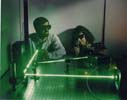Jefferson Lab in the News
Jefferson Laser Team Meets Goal
Beam Reaches Record 1,720 Watts
For a few seconds, it was like a golf ball hovering on the rim of a hole without dropping. Except at the Thomas Jefferson National Accelerator Facility, the ball dropped.
Thursday night, the lab's free-electron laser briefly flickered off when the power of its light beam reached 990 watts. As scientists held their breath, it turned back on and passed the 1,000-watt mark - topping the project's goal and prompting one scientist to grab another and do a quick tango.
The light ended up hitting 1,720 watts, making it 1.7 million times more powerful than lasers used in CD players and beams that read prices at grocery stores. With the brighter light, the laser will be able to work more quickly and precisely in industry and research projects.
"Our hearts skipped a beat for a minute when it turned off for those few seconds," said Fred Dylla, manager of the free-electron laser, or FEL, program. "Then we were screaming, and then we were speechless."

|
Researchers are interested in using the laser for work ranging from finding tiny defects in silicon chips to melting the surface of polyester fiber to make it softer. Brighter light will allow for a more detailed look at transparent surfaces such as silicon and also would let companies treat materials faster and at a lower cost.
Exceeding the goal for the laser also should help the lab solidify its case for getting funding to build an even more powerful version, Dylla said.
The lab's laser, which can cut through any material, is far more powerful than others of its type. The closest is a Japanese laser that has operated for brief periods at 100 watts, Dylla said. The Jefferson Lab's laser stayed above 1,000 watts for 30 minutes and can remain there as long as scientists want, he said.
"This just leaves everything else in the dust," he said.
The FEL is a spinoff project for the lab, whose main mission is to probe the basic structure of atoms. Completely enclosed and kept underground to protect scientists, the laser works by reflecting light with mirrors.
The equipment extracts energy from electrons, or particles of atoms that are easy to accelerate to high energies. The term "free-electron" refers to the electrons moving through a vacuum with no air molecules to slow their course.
The laser produced its first light in June 1998, hitting 155 watts. This spring, it was hovering around 720 watts, said Linda Ware, spokeswoman for the lab. The difference came when researchers installed better-quality mirrors - ones that reflect more light - on Tuesday.
Even at lower power, the laser makes quick work of many materials. For example, it bored a hole through a hard piece of ceramic, about an eighth-inch thick, in a matter of seconds at 10 watts, he said. Metals are even easier to cut.
To date, four groups have received grants to work with the laser. Vanderbilt University in Nashville, Tenn., will use it to look for defects in silicon chips. A professor backed by Norfolk State University and the Jefferson Lab will use the light to initiate chemical reactions and make high-purity materials for electronics.
At the College of William and Mary, researchers want to produce high-quality, thin films of magnetic material that could be used to create computer disks with more memory. And Northrop Grumman has a grant from NASA to create very lightweight plastics by using the laser to cut away material on plastic films and make them even thinner. That plastic could be used on less-expensive, next-generation spacecraft, Dylla said.
A number of companies are interested in using the laser - such as DuPont, which wants to use it to treat the surface of polyester.
The FEL project recently got new endorsement from the Navy, which sees the laser as a tool to protect against the growing threat of cruise missiles. Lawmakers have inserted millions of dollars into next year's defense budget to make the laser at least 10, and possibly 20, times more powerful than it is today.
If the anticipated funding comes through, the lab hopes to design an upgraded laser over the next two years and start installing additional equipment in about three years.

